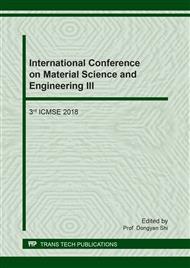[1]
R. Al-Itry, K. Lamnawar, A. Maazouz, Rheological, morphological, and interfacial properties of compatibilized PLA/PBAT blends, Rheolog. Acta. 53 (2014) 501-517.
DOI: 10.1007/s00397-014-0774-2
Google Scholar
[2]
P. Ma, X. Cai, Y. Zhang, S. Wang, W. Dong, M. Chen, P. J. Lemstra, In-situ compatibilization of poly(lactic acid) and poly(butylene adipate-co-terephthalate) blends by using dicumyl peroxide as a free-radical initiator, Polym. Degradat. Stabil. 102 (2014).
DOI: 10.1016/j.polymdegradstab.2014.01.025
Google Scholar
[3]
L. Cardoso Arruda, M. Magaton, R. E. S. Bretas, M. M. Ueki, Influence of chain extender on mechanical, thermal and morphological properties of blown films of PLA/PBAT blends, Polym. Test. 43 (2015) 27-37.
DOI: 10.1016/j.polymertesting.2015.02.005
Google Scholar
[4]
K. Hashima, S. Nishitsuji, T. Inoue, Structure-properties of super-tough PLA alloy with excellent heat resistance, Polymer. 51 (2010) 3934-3939.
DOI: 10.1016/j.polymer.2010.06.045
Google Scholar
[5]
N. J. Wu, H. Zhang, Mechanical properties and phase morphology of super-tough PLA/PBAT/EMA-GMA multicomponent blends, Mater. Lett. 192 (2017) 17-20.
DOI: 10.1016/j.matlet.2017.01.063
Google Scholar
[6]
M. Kumar, S. Mohanty, S. Nayak. Effect of glycidyl methacrylate (GMA) on the thermal, mechanical and morphological property of biodegradable PLA/PBAT blend and its nanocomposites, Bioresour. Tech. 101 (2010) 8406-8415.
DOI: 10.1016/j.biortech.2010.05.075
Google Scholar
[7]
J. D. Jiang, L. L. Su, K. Zhang, G. Z. Wu, Rubber-toughened PLA blends with low thermal expansion, J. Appl. Polym. Sci. 128 (2013) 3993-4000.
DOI: 10.1002/app.38642
Google Scholar
[8]
Y. H. Zhou, L. Lei, B. Yang, J. B. Li, J. Ren, Preparation of PLA-based nanocomposites modified by nanoattapulgite with good toughness-strength balance, Polym. Test. 60 (2017) 78-83.
DOI: 10.1016/j.polymertesting.2017.03.007
Google Scholar
[9]
P. Zhao, W. Q. Liu, Q. S., and J. Ren, Preparation,Mechanical, and Thermal Properties of Biodegradable Polyesters/Poly(Lactic Acid) Blends, J. Nanomater. 2009 (2010) 1-8.
DOI: 10.1155/2010/287082
Google Scholar
[10]
A. M. Zolali, B. D. Favis. Compatibilization and toughening of co-continuous ternary blends via partially wet droplets at the interface, Polymer. 114 (2017) 277-288.
DOI: 10.1016/j.polymer.2017.02.093
Google Scholar
[11]
J. Punmanee, R. Chaiwat, C. Pranee. Effect of glycidyl methacrylate-grafted natural rubber on physical properties of polylactic acid and natural rubber blends, J. Appl. Polym. Sci. 125 (2012) 745-754.
DOI: 10.1002/app.36263
Google Scholar


